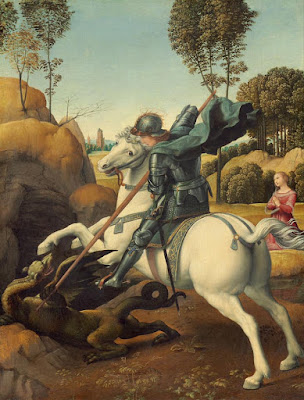ST. GEORGE DAY (APRIL 23RD)
 |
| St. George and the Dragon, by Raphael |
Edited by Bp. Joseph (Ancient Church of the West)
Today, April 23rd, we celebrate the memory of St. George the Martyr, heroic soldier, faithful Christian, and slayer of a “dragon”! For those of us in the English Patrimony, St. George is famous as the patron saint of England and a symbol of strength and Orthodoxy within our Tradition.
Over the last few centuries, the story of St. George has been corrected by historical research, and the discovery of several important Roman imperial documents in the Vatican’s libraries that give us the true story of St. George’s Christian life and death. The saint's father died when he was young, and his faithful Christian mother inherited a large estate which she later bequeathed to her son. St. George became a general in the army of the Roman Emperor Diocletian, but during the Diocletianic Persecution of Christians he declared himself publicly to believe in Jesus Christ, tore down the Emperor's edict of persecution, and refused to harm his brothers and sisters in the Faith. For this act of defiance, St. George was tortured and dragged behind horses through the streets by his fellow Roman soldiers, but he would not renounce his Christianity. The saint was then beheaded on April 23, 303AD. After his death, a large number of soldiers converted to Christ, and many venerated him for his bravery in standing up to the powerful Emperor.
 |
| Sts. Theodore and George shown side by side as equestrian heroes. St. Theodore kills a dragon and St. George overcomes a human enemy. Saint Catherine's Monastery, Sinai, 9th or 10th century |
Historians now know that Christian Syriac preserves the oldest complete hagiography of St. George’s life in a manuscript from around 600AD. In this story, there is no scaly, be-winged, fire-breathing beast. Instead, Emperor Diocletian is called ܚܶܘܝܐ ܓܳܪܣܐ /ḥewya gorsa/a snake that fatally kills. Satan, for example, is the "great gorsa" in Syriac literature. Early Syriac iconography depicts a large snake being defeated by St. George as a way of referring to the evil Emperor. Later, in 11th century Georgia, the hagiographies transform the snake of the Syriac tale into the more familiar character of a dragon that we know today. European Crusaders took the story of “St. George and the Dragon” back with them to Europe, and over time, the fire-breathing monster became bigger and bigger in the Western imagination. The British loved the story so much that, after a period of time, St. George replaced St. Edmund as the patron saint of England!
Collect for St. George -
O GOD, who didst grant to Saint George strength and constancy in the various torments which he sustained for our holy faith; we beseech Thee to preserve, through his intercession, our faith from wavering and doubt, so that we may serve Thee with a sincere heart faithfully unto death. Through Christ our Lord. Amen.



Comments
Post a Comment